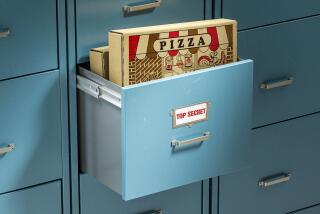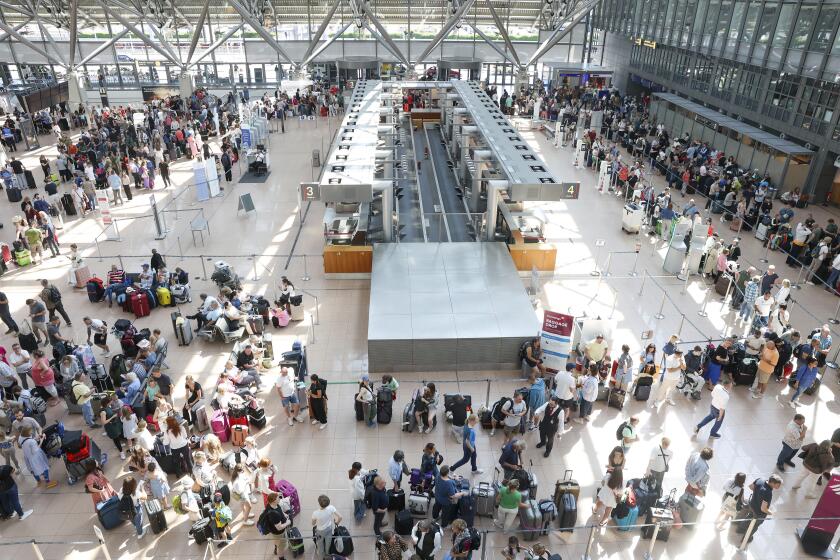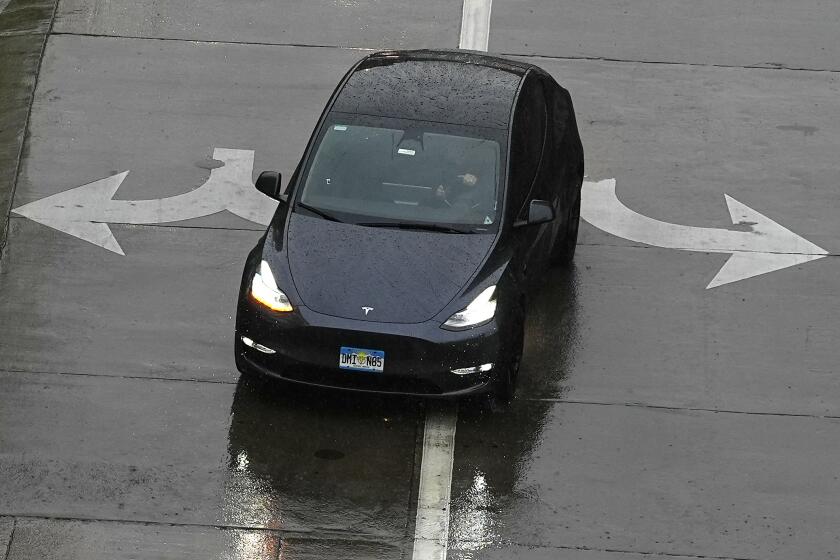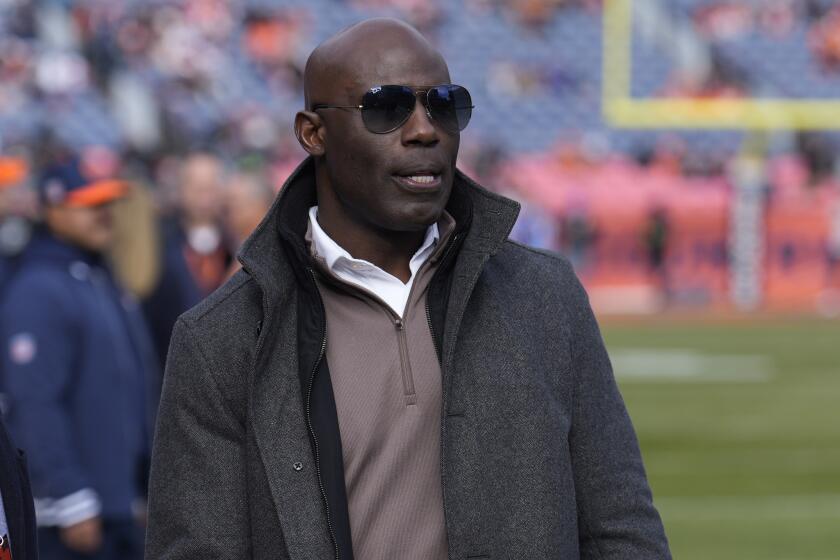PSA Crash Liability Case May Hinge on Airport Security
A former supervisor turned down David A. Burke’s request to be rehired about two hours before Burke shot the supervisor as part of an on-board attack blamed for the crash of a Pacific Southwest Airlines jetliner near Paso Robles in December, 1987, according to court records and a key attorney involved in the case.
These documents and interviews with the lawyer offer the most detailed account to date of what apparently motivated Burke to open fire aboard the plane. Major testimony is scheduled to begin this week in the massive civil liability trial resulting from the crash.
Pretrial briefs indicate that the trial, expected to last several months, will include detailed accounts of Burke’s troubled life and his successful plan to elude PSA’s passenger screening system at Los Angeles International Airport and smuggle a gun onto the plane.
Meeting in Office
Trial briefs filed in Los Angeles Superior Court state that Burke, 35, who had been accused of theft and fired from his job as a USAir ticket agent by Raymond Thomson, walked into Thomson’s office at the Los Angeles airport about 2 p.m. on Dec. 9, 1987, to ask for his old job back.
Thomson, 48, a station manager for USAir, the parent company that later acquired PSA, took six pages of meticulous notes during the half-hour meeting with his former subordinate, according to Gerald Sterns, a member of the legal team representing plaintiffs in 35 cases consolidated for the trail.
“Burke told him he wanted his job back,” Sterns said. “Burke said he wanted counseling for drug and alcohol problems. Said he would trade grievances that he had filed (against USAir) for dropping the (theft) charges. Thomson said no, but he would take up the rehabilitation matter with a supervisor.”
A few minutes later, both men left the office, separately, to take Flight 1771 to San Francisco, according to the trial briefs and Sterns.
“A secretary said Burke looked confident, almost arrogant, when he walked out at about 2:30,” Sterns said. “The secretary said Thomson looked red-faced, upset.”
About an hour later, PSA flight 1771 took off for San Francisco with 43 aboard, among them Burke and Thomson.
While evidence is fragmentary because of the force of the crash, there is general agreement about what happened aboard Flight 1771. The National Transportation Safety Board, the FBI and lawyers who have studied the incident have all concluded that sometime after takeoff, Burke shot Thomson in an act of revenge for being fired.
Investigators agree that Burke then invaded the cockpit and attacked the pilot and co-pilot with a pistol. The attack apparently caused the cockpit crew to slump over the controls, sending the plane into a steep dive that exceeded the speed of sound on impact. The crash killed all those on board who were not already dead.
The arguments that remain--and tens of millions of dollars hang in the balance--center around the question of how Burke was able to smuggle that pistol, a massive and powerful weapon known in some circles as a “Dirty Harry,” onto the plane.
Defendants in the trial asked Judge Jack T. Ryburn to close portions of the trial to the public and news media, arguing that air safety could be jeopardized if the screening procedures were made public.
Sterns responded that discussion of the procedures in effect in December, 1987, would not affect public safety, since the Federal Aviation Administration changed security procedures as a result of the incident.
Sensitive Issues
Ryburn said last week he is committed to keeping the trial open, but would consider closing the courtroom if sensitive material is to be discussed.
The defendants in the complex case are the Los Angeles Department of Airports, through whose buildings Burke allegedly smuggled the .44 magnum revolver; the Ogden Allied Security Co., which PSA paid to handle the passenger screening services at the terminal from which Flight 1171 departed; PSA and USAir.
The defendants have counter-sued Burke’s estate, arguing that the crash was a criminal act that cannot be blamed on the airlines, the security company or the City of Los Angeles.
While the question of blame is sure to be a matter of some debate in the trial, FAA regulations stipulate that airport passenger and luggage screening is the responsibility of the individual airlines.
No one is willing to say precisely how much in damages is being sought or has already been received by the plaintiffs. But Sterns said all but “about a dozen” of the 35 civil liability cases consolidated for trial have been settled out of court.
Sterns said the the U.S. Aviation Insurance Group, which insures most carriers against the sorts of losses incurred in air crashes, has paid amounts “well up into seven figures” in the individual cases. The insurance company has declined comment. The Times was unable to elicit comment from attorneys for the defendants.
Troubled Man
In an interview last week, Sterns--who has successfully represented plaintiffs in about 20 airline-accident civil liability cases--described Burke as a “man who was troubled from the word go.”
A trial brief filed by Sterns’ team noted that Burke’s 16-year employment by USAir “had seen its ups and downs,” including admitted drug and alcohol abuse problems and suspicions that he had stolen funds from a passenger overcharged for excess baggage, that he had dealt in narcotics and that he had been involved in a car-theft ring.
These problems culminated about three weeks before the crash when Burke was fired for allegedly stealing $69 in cocktail receipts. According to Sterns, Burke surrendered two USAir ID cards, but kept a third, apparently without the knowledge of the airline.
Not long after Burke was fired, he flew to San Francisco, where he borrowed the .44 magnum pistol from a friend, USAir supervisor Joseph Drabik, according to Sterns. “Burke claimed he needed it because he was going to be carrying large amounts of money from real estate transactions,” Sterns said.
According to a brief Sterns filed with the court, Drabik then drove Burke to San Francisco International Airport, carrying along a duffel bag containing the gun--called a “Dirty Harry” because one like it was used by a movie character of that name played by actor Clint Eastwood.
Security Question
Just how Burke got the weapon through the security checkpoint at San Francisco was not made clear, according to Sterns.
At about 1:30 p.m. on the day of the crash, Burke approached the PSA passenger screening checkpoint at Los Angeles airport, Sterns said.
“There was a lady on duty at the bypass point,” the attorney said. “Here comes Burke, in a business suit. He’s got a badge. His face matches the badge. She thinks everything is cool.”
Sterns said the woman was supposed to see if the badge was current (it was not) and, because Burke was out of uniform, search his person.
“But none of this was done,” Sterns said. “She just says, ‘Have a nice day,’ ” Sterns said. “And he replies, ‘I’ll have a very nice day.’ ”
Sterns said the woman, whom he did not identify, does not recall what, if anything, Burke carried with him through the checkpoint. But the attorney theorizes that Burke had the gun with him and that once inside the checkpoint, he placed it in one of the lockers there.
“The next thing we know, he turns up, back on the public side of the checkpoint, at about 2 p.m.,” Sterns said. “That was when he went to Thomson’s office.”
After his fruitless attempt to get his old job back, Burke stopped by a PSA passenger counter, where he purchased a ticket.
“That was the last time anyone saw him,” Sterns said.
Flight 1771 took off at 3:36 p.m.
Note Sketched on Bag
Investigators believe that about a half hour after the plane became airborne, Burke handed Thomson a note, scribbled on an airsickness bag. The note, later recovered from the wreckage, read:
“Hi, Ray. I think it’s sort of ironical that we ended up like this. I asked for some leniency for my family. Remember? Well, I got none and you’ll get none.”
Investigators say Burke then fired two shots--presumably at Thomson--somewhere in the main passenger cabin of the British-built BAe-146 jet. The sounds of these shots were picked up on the “black box” cockpit voice recorder later recovered from the wreckage of the plane.
Air traffic controllers in Oakland heard the pilot radio that “there’s gunfire aboard.”
The recorder then picked up the voice of a woman--presumably a flight attendant--warning the captain of trouble.
“Immediately thereafter, there was an unlawful entry into the cockpit, followed by three sharp reports which sound like gunshots,” the FBI said. “Some commotion was heard in the cockpit area, and shortly before the recording ended, another sharp report which sounded like a gunshot.”
The bodies of the victims were too mangled to determine whether any had suffered gunshot wounds. But the FBI report accounts for all six bullets from the gun, which contained six empty shell casings when recovered from the wreckage.
Investigators presume Burke fired two of the bullets at Thomson, three of them at the cockpit crew and the sixth to claim his own life.
Radar data show that the four-engine plane arced over in a slow curve, slamming nose first into the rugged coastal backcountry of San Luis Obispo County at more than 700 m.p.h.
More to Read
Sign up for Essential California
The most important California stories and recommendations in your inbox every morning.
You may occasionally receive promotional content from the Los Angeles Times.






